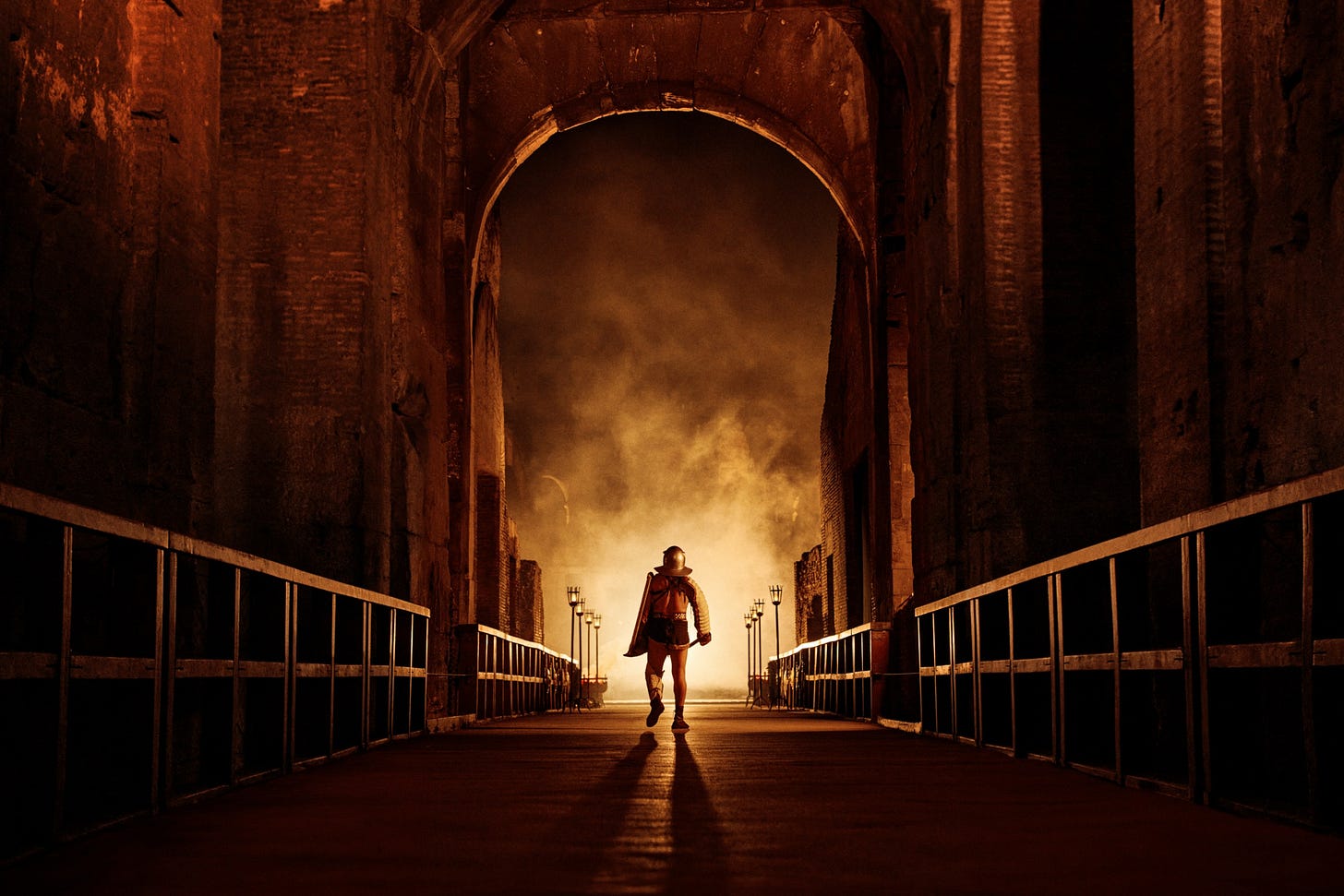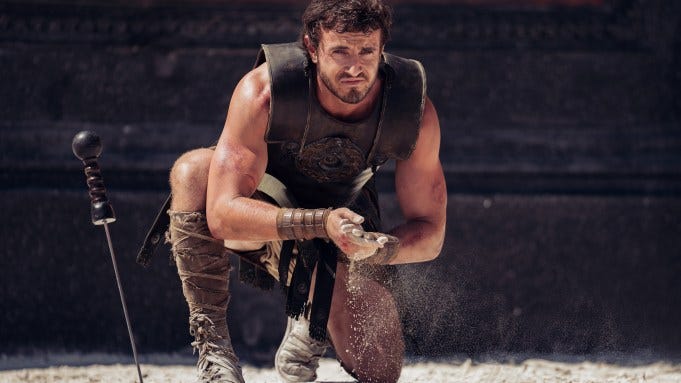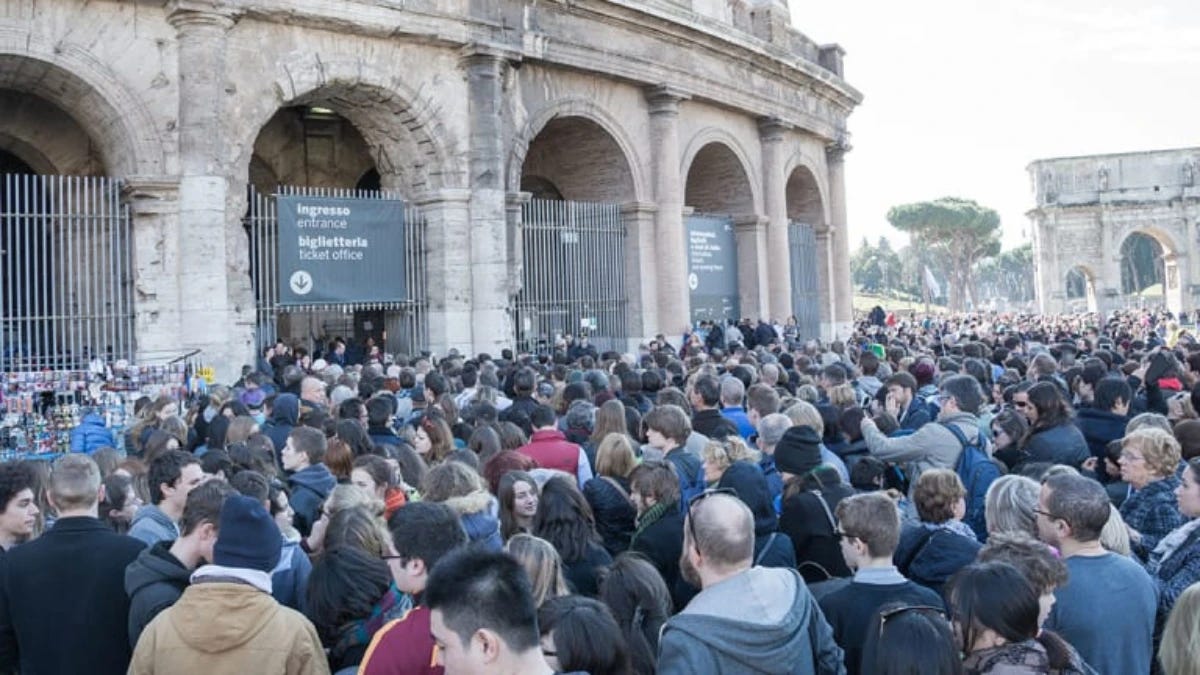Gladiator play-fights are the newest oldest distraction
Rome is a theme park and the Colosseum is it's hottest ride
Airbnb has partnered with Paramount Pictures to bring gladiator fights back to the Colosseum. Set to debut in May 2025, the exclusive, two-day-only experience is the latest marketing ploy for Gladiator II. With the support of the Colosseum Foundation, and in collaboration with historical reenactment groups Ars Dimicandi and Gruppo Storico Romani, the initiative promises:
“You will hear the echoes of gladiators past in the Colosseum’s catacombs and the unmistakable clank of steel in its arena. You will see the moon’s reflection off the travertine stone through the sweat dripping down your face. You will become a gladiator.”
16 participants will be randomly selected to attend this free experience, which will include: access to the Colosseum after dark, a tour of its underground chambers, and a training session in gladiatorial combat. Visitors will get to pick our their gladiator armor, snack on period-appropriate refreshments like grapes and nuts, and ultimately face off against each other in a simulated battle.
Airbnb claims this event follows a “series of measures and commitments by the platform to revitalize heritage tourism in Europe”, underscored by their donation of €1 million to restoration efforts at the Colosseum.
Valentina Reino, Head of Airbnb Italy Institutional Relations, described the collaboration as a way for “a larger public to utilize spaces in a way in which the collective imagination will become even closer with historical realities”. And Alfonsina Russo, director of the Colosseum Archeological Park highlighted that “the goal of the collaboration is to enhance the historical and cultural heritage through immersive activities that fully respect the monument, based on rigorous historical research.”
Amidst all the buzz a number of critics have raised questions about the implications of this partnership.
Erica Battaglia, president of Rome’s Culture Commission, warned against reducing the Colosseum to “a place of pranks for a select few”. Similarly, Massimiliano Smeriglio, Councilor for Culture of Rome Capital, called the initiative a “principle of commodification and consumerism of culture”. Smeriglio, who is leading a campaign asking Airbnb’s CEO to shut down the initiative, pointed to a larger concern about Europe’s already strained tourism model: “we cannot transform one of the most important monuments of the world into a themed park“.
Personally, I’m not a fan. I don’t think this initiative is about preserving and celebrating heritage. Rather, it reads like another lucrative campaign by big corporations - one that exacerbates Europe’s overtourism crisis by reducing landmarks to commodities.
I also think that gathering a bunch of adults, feeding them grapes and nuts, and having them prance around pretending to be Paul Mescal in sandals - and labeling it as “enriching” - is just generally tacky.
Europe has a tourism issue, but few solutions
It’s obvious who Airbnb’s initiative is targeting - and it’s not the locals of Rome. The timing of the registration - a convenient evening slot for Americans but a brutal 3 AM for Italians, coupled with the reminder that “guests are responsible for their own travel to and from Rome, Italy”, makes it clear that the experience is aimed at tourists.
Overtourism, and it’s mitigation, is an issue in Europe. And don’t get me wrong, this is not a problem caused (solely) by tourists (tourism accounts for 10% of Europe’s GDP, many economies depend on visitor dollars), but by an approach to tourism aimed at getting visitors back after the post-pandemic lull instead of working to develop a sustainable model.
Little has been done to try and manage the influx and the most common solution proposed has been a small fee for tourists. Venice, for instance, trialed ticketed entry from April to August. Santorini implemented docking fees for cruise ships, and Rome has floated similar ideas, including a possible fee for visiting the Trevi Fountain. But these measures don’t address the root issue and flows remain unmanaged. A €5 ticket to Venice or a €20 docking fee in Santorini isn’t going to deter someone who has these places on their bucket list and visitor numbers continue to rise despite these barriers.
On top of that, Airbnb already has a rocky reputation across much of Europe and is directly capitalizing from its overtourism - an issue it helped fuel. The company’s short-term rental model has contributed to housing crises across popular tourist destinations. Barcelona, for example, plans to ban Airbnbs by 2028. And in Rome alone, short-term rentals increased by 37.3% in 2023, making it the second most affected city in Europe after Amsterdam. With the upcoming Jubilee in 2025, set to bring 32 million pilgrims to the city, the gladiator initiative feels more like opportunism than conservation.
Plus, it’s not like the Colosseum needs any more publicity. It already draws massive crowds - 16,000 visitors daily. Rather than addressing the strain on the city’s infrastructure or the challenges of overcrowding, marketing the “gladiator dream” adds even more hype to a destination overwhelmed by poorly managed tourism - and further alienates residents.
What’s the longest you’ve waited in line for a museum or landmark?
Heritage as a commodity
Before we get into this section, a disclaimer:
I am not some kind of tangible heritage purist. I don’t think heritage should sit untouched - distant and cold and boring and inaccessible. It should be engaged with, explored, visited, and talked about. It’s not sacred or something to be revered. Yes, it holds value(s), not necessarily the “universal value” we’re so quick to slap on it - I don’t care much for that. It’s valuable because it’s got some pretty interesting stories to tell, because learning about the past helps us navigate the present. It’s a tool to talk about who we used to be, what we’ve done, how we’ve changed. And landmarks, history, and artifacts are just generally cool and interesting to look at.
From a heritage management standpoint, this initiative bothers me because of the blatant commercialization of the Colosseum.
Making heritage sites more accessible and interactive can be hugely beneficial. Think of the rise of edutainment - the blending of education and entertainment. Done well, it can be incredibly effective; examples are audio guides, interactive panels, or participatory museum exhibits. But initiatives like Airbnb’s gladiator experience take the edu out of edutainment, reducing it to pure spectacle. The result is heritage is reduced to a quick hit of amusement. It becomes something to be consumed.
The commodification of art and heritage isn’t a new phenomenon. Frida Kahlo’s face is plastered on everything from coffee mugs to tote bags, Van Gogh’s agony is softened into sunflower keychains and Starry Night throw blankets, and an ‘immersive exhibition’ pops up every other week, transforming complex works into little more than Instagram backdrops. This diminishes the cultural significance of these works and sites. It warps how we interact with them. It encourages us to see heritage as a product to purchase, an experience to check off a list.
These initiatives are nothing more than a distraction. Gimmicks to capture our attention. They prioritize spectacle over substance, and strip heritage of the stories that give it value.
But who cares about all that when there’s money to be made, a new blockbuster to promote, and sandals to be worn while play-fighting? After all, isn’t Airbnb using the Colosseum exactly the way it was intended? A place for games and distraction?
Panem et Circenses
Panem et Circenses is a latin phrase that translates to “bread and circuses”. It was coined by satirical poet Decimus Juvenal (55-ish AD), who used it to criticize the corruption and decadence of Rome. He used the phrase describe a strategy used by populist politicians to win the votes of the poor population: giving them cheap food and entertainment with performances. The Colosseum is an example of this.
To consolidate his position as emperor with the Empire close to ruin, Emperor Vespasian commissioned the construction of the Flavian amphitheater, now commonly known as the Colosseum. The goal was to provide entertainment to the masses to appease public discontent and win over popular support in response to the recent struggle and instability of the Empire. To create a distraction. As long as people are absorbed by spectacle, they forget their personal problems and remain passive in the face of the abuses of power.
Remind you of anything?
Panem et Circenses is still relevant, but the mechanisms of distraction have evolved. In a world that feels overwhelming, many of us actively seek out distractions to escape the realities of modern life. Entertainment and easy access to things keep us compliant and soft, anything more than that is exhausting.
When Airbnb offers you the opportunity to armor up and wield a gladiator’s sword, you jump to it because these are experiences designed to be consumed, not questioned. We eagerly accept the crumbs offered to us, much like the Roman crowds who cheered for blood in the arena.
“Give them bread and circuses and they will never revolt”
The Colosseum is going back to its initial function, ignoring the ways in which its value has evolved and altered through time. A return to form that doesn’t honor its history, but bypasses it entirely.
If you enjoyed this article, you might also like:












